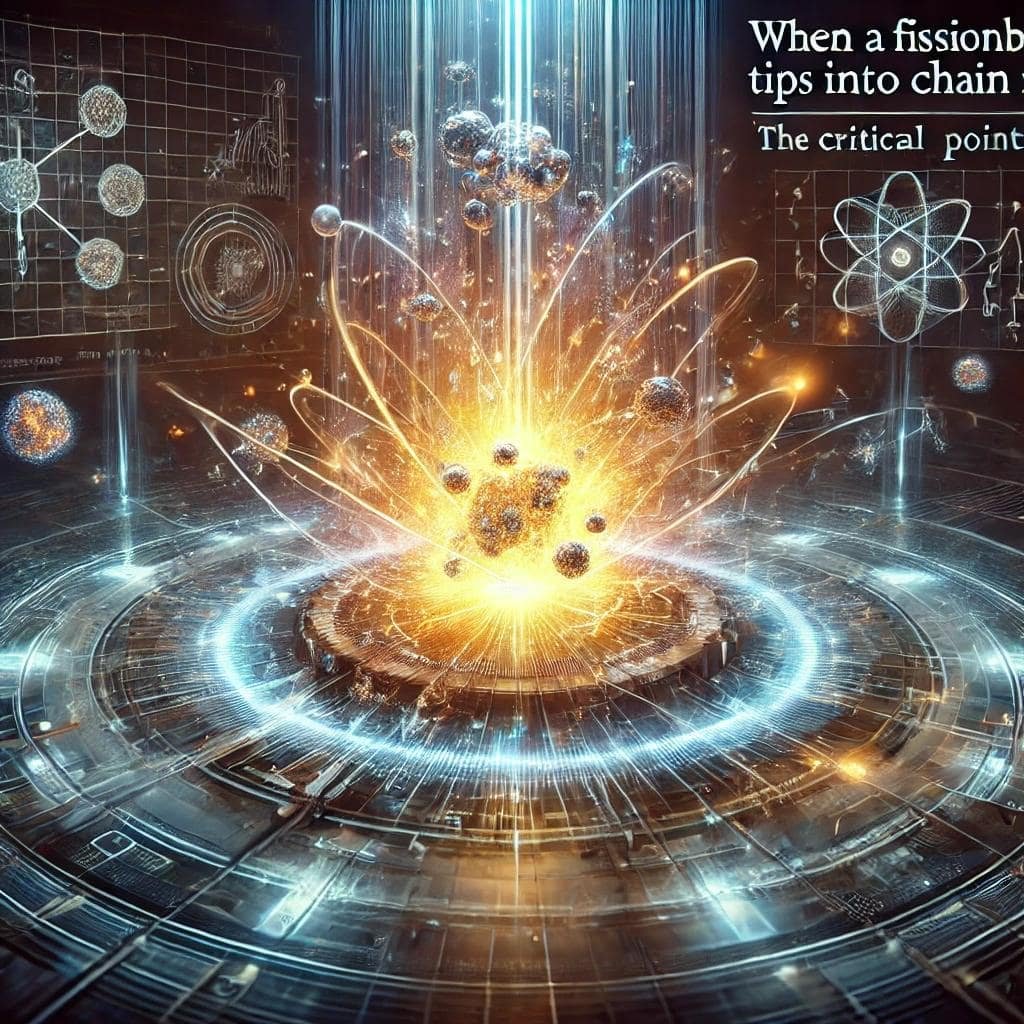Introduction: In nuclear science, comprehending when fissionable mass tips into a chain reaction is vital. One fundamental facet concerns when a fissionable mass crosses the threshold into a chain reaction. This phrase captures a critical moment during a nuclear detonation. Still, in truth, understanding chain reactions in terms of fission and fissionable materials helps break down the terrifying yet fascinating occurrence of a nuclear explosion into understandable parts.
In the current context, insofar as we are discussing the potential hazards of fissile materials, we need to play out some scenarios concerning chain reactions. These are largely hypothetical. We will also look at the energy released during a chain reaction. Understanding this energy output in terms of “TNT equivalence” will give us a better feel for just how much energy is liberated during such an event.
Understanding Fission: What Happens When Fissionable Mass Tips into Chain Reaction?
Nuclear physics experiences a fundamental moment when fissile mass undergoes a chain reaction. Fission is a process wherein the nucleus of an atom splits into two or more smaller nuclei, and it splits for no more than three or four times. Uranium, for instance, will produce three or four neutrons. A fissile material’s fission won’t cause a problem for anybody unless that material is assembled into a mass that’s large enough to guarantee that the neutrons produced by the first fission will go on to cause more fissions—that is, to do something that uranium and plutonium do, in a controlled way, in a power reactor, and in an uncontrolled way, in an atomic bomb.
The Basics of Nuclear Fission and Chain Reactions
When an atom’s nucleus is divided into smaller parts, a large amount of energy is released. This is nuclear fission; it is at the heart of understanding how fissionable mass can turn into a chain reaction, which, when uncontrolled, can result in explosions like those that occurred at Hiroshima and Nagasaki and, when controlled, can provide the stable and safe source of energy that a nuclear reactor can represent.
A chain reaction occurs when the products of one fission event cause other adjacent nuclei to undergo fission. Several specific conditions are needed for a chain reaction to occur. The most important of these is having enough fissile material present in a volume we call “supercritical.” It is assured that way in the bomb, in the reactor, and out of the many ways in which we can unsafe or safely harness nuclear fission experimentally.
Key Factors That Lead to a Chain Reaction in Fissionable Mass
Several things contribute to fissionable mass tipping into a chain reaction. First is composition. Only certain specific isotopes—like uranium-235 and plutonium-239—can sustain chain-reaction conditions. Next is arrangement. The essential “critical mass” must ensure that enough atoms are present to continue the reaction. Then there is density.
The more atoms in a given volume, the more likely that one atom will strike another in a way that will keep the reaction moving. Finally, there are the environment and conditions. Temperature and pressure must be within “certain limits” for a chain reaction to be self-sustaining. If these factors are too far out of balance, the result is either a fizzle or an explosion.
The Science Behind Chain Reactions: How Fissionable Mass Behaves?
Study of the behaviour of fissionable materials during chain reactions is very interesting. When a fissionable mass starts to undergo a chain reaction—that is, when it is tipped into a chain reaction—the changes it undergoes are very rapid and also very dramatic. At first, when a neutron collides with a fissile atom, it causes the atom’s nucleus to split. This fission releases a great deal of energy (as much as 200 MeV per fission) and, importantly, two or three neutrons.
Whether we consider uranium-235 or plutonium-239 as representatives of fissionable materials, we find that the average number of neutrons released per fission event is around 2.5—that is, for every three atoms that split, two do not go on to split further. Still, it is a very good gamble that a chain reaction in a fissionable mass will be maintained once it has started. At a minimum, we need to know why it is such a good gamble.
Exploring the Conditions Necessary for a Chain Reaction
A successful chain reaction isn’t something that just happens; several factors must come together for it to occur. Most importantly, the mass of fissionable material must be sufficient for a “population” of nuclei to keep the reaction going. This is the mass ‘criterion’, and it guarantees that the necessary number of fission events will occur in a given time.
Just as crucial, however, is the probable arrangement of the mass. It must be in a form that permits a neutron released during a fission event to interact with another nucleus rather than to escape into the surroundings. Other conditions come into play as well, but these are the principal considerations.
The Role of Neutrons in Initiating Chain Reactions
The nuclear fission process and the subsequent reactions are carried by the neutrons. When a mass capable of fission does initiate a chain reaction, it usually does so when a neutron is absorbed by a fissile nucleus. The fissile nucleus becomes unstable, and faulty neutron management can lead to the “safety” problems often associated with nuclear reactors. Control over the fission process necessitates control over the neutrons, which is why engineers utilize control rods made of neutron-absorbing materials to keep a nuclear reaction either underway or safely shut down.
Historical Examples of Chain Reactions in Nuclear Fission
Significant historical events have marked the occurrence of nuclear fission chain reactions. The first managed chain reaction took place in 1942 under the direction of Enrico Fermi at the University of Chicago. This experiment showed that it was possible to use fission to produce a large amount of energy. The atomic bomb, developed during World War II, was an example of a situation where an enormous amount of energy was released in an instant without any control over the chain reaction. If these two incidents tell us anything, it’s that nuclear fission has a dual nature: it can be a powerful source of energy, but it can also be really dangerous.
Safety Measures in Nuclear Reactors: Preventing Uncontrolled Chain Reactions
Ensuring safety in nuclear reactors is of primary importance, especially concerning chain reactions. Something happens when fissionable mass crosses a certain threshold that could be considered similar to what happens in a nuclear explosion. Although this is probably a worst-case scenario and not something that we would typically associate with a civilian nuclear power plant, it does give you an idea of how serious uncontrolled chain reactions are.
Control rods (made of a fissionable substance) serve as the main safety features to ensure that something like this doesn’t happen. They are inserted into and removed from the reactor core as needed to maintain a constant power output. … Of course, if something completely catastrophic should happen, the humans inside those reactors could be facing a radiation release much like the one eventually encountered by the humans inside those P-51s and their B-17 escort.
Applications of Controlled Chain Reactions in Energy Production
Energy creation through controlled nuclear chain reactions holds vast potential for the future. Power plants utilize the fission of uranium or plutonium to produce heat. That heat then turns water into steam, and the turbogenerators that run on that steam output use the thermal energy of the steam to generate electrical energy.
In layman’s terms, this is how potential energy in the fuel is released, and the mechanism of release is not too terribly different in principle from how fossil fuels combust—although, in this case, the fuel and the working parts of the machinery to accomplish the task are not so different from the way the combustion parts of an internal combustion engine work.
Common Misconceptions About Fission and Chain Reactions
Nuclear fission and chain reactions are commonly misunderstood. Many people believe that fission always results in explosions. But when people talk about “controlled chain reactions,” they’re talking about how nuclear power plants work. Reactor engineers manage these power-producing fissioning atoms of uranium or plutonium so that they’re harmless.
Another misconception is that fissionable materials are always dangerous. They aren’t. But don’t let that mislead you: They’re not safe; if you have any, you’re doing something illegal. … Despite appearances, the discussion of nuclear power plants has everything to do with explosions and survival. “Nuclear” power is not safe and could hardly be made so without making it dangerous.
How Scientists Study Fissionable Mass and Chain Reactions?
The fissionable mass and chain reactions are studied by scientists using various methods. They set up controlled experiments to see what happens when fissionable mass is brought to the verge of becoming a chain reaction. Most of the work still done today to understand this process is carried out with particle accelerators and nuclear reactors, where scientists can manipulate and measure many variables (controlled and uncontrolled) that would be present in a real nuclear incident.
These setups allow one to see in some detail what part of a critical mass of nuclear fuel is doing when criticality is not quite fully reached or when it is safely in a state of reactivity that simulates a loss of control. Another way scientists study fission and chain reactions is by using computers to perform highly detailed simulations of what different materials and configurations might do under various kinds of stress. Scientists also consult the historical record of past nuclear accidents to figure out how to make reactors and accelerators safer.
What You Need to Know About Fissionable Mass and Chain Reactions?
Nuclear science is a field of knowledge that demands understanding the basics. Fissionable mass and chain reactions tip us into a real-world scenario where nuclear energy can be harnessed for useful purposes. These phenomena occur in specific materials and under certain conditions. The materials that can undergo fission include uranium-235 and plutonium-239, both of which are found in nuclear weapons.
With some differences in design and construction, they also provide the basis for nuclear reactors. On that account alone, fissionable mass and controlled chain reactions are of great concern to all civilized states. And in the U.S. since 1945, they have also been a matter of great national concern. Knowledge of that basis is at the heart of any conversation about nuclear energy.
The Importance of Understanding When Fissionable Mass Tips Into Chain Reaction
Grasping the concepts of fission and chain reactions is crucial for contemporary energy arrangements. As the world moves toward an energy mix that is less reliant on fossil fuels, nuclear power emerges as a “clean” option; its fission process yields very little other than heat and radiation—as opposed to carbon emissions—that can be harnessed in power plants.
The problem, however, is that nuclear materials have the potential to create both great power and great danger. This series of articles attempts to shine a light on the basic nuclear science behind these phenomena, what they mean for our potential use of nuclear power in the future, and the kind of nuclear research and development that could be necessary to make this option truly safe and viable.
The Future of Nuclear Energy: Advancements in Chain Reaction Technology
Nuclear energy looks bright and is a good candidate to be part of the future low-carbon energy supply, but when it comes to the technological advancements discussed by nuclear advocates, safety and efficiency do have a role to play in the assurance of a low-carbon energy future. We’re not just talking about the next generation of power plants being built to a different safety standard than half a century ago.
Improvements are being made in the fundamental materials and physics of chain reactions. If you stop and think about what providing better safety and containment for nuclear power means, you have to acknowledge that this energy source will depend increasingly on a large-scale mining and enrichment program that carries with it substantial environmental risks—unless we switch to using thorium.
Conclusion
To wrap up, the idea that a critical mass of fissionable material can go into a when fissionable mass tips into a chain reaction is an absolutely basic concept of nuclear science. It’s something all of us who studied nuclear physics had to understand. It is clear from the discussions in this chapter that it is not enough just to understand the energy release; one must also understand what happens to the materials that can split and what happens to the materials near them when they start to split. This is especially true if you want to make statements about the safety and secure use of nuclear power plants and the future of nuclear power as a sustainable energy technology.









